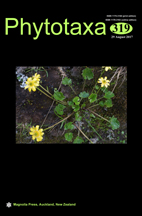Abstract
A new, probably endemic species, Orobanche mlokosiewiczii (Orobanchaceae) is described from Georgia, in the Greater Caucasus. The species grows near waterfalls, on slopes with thermo-hygrophilous subalpine tall herbaceous vegetation, and is exclusively parasitic of another endemic species: Aconitum cymbulatum. It is a graceful whitish or pale white-yellow plant, characterised by campanulate flowers and usually a very wide open throat of corolla. So far, for the Orobanche parasite on Aconitum (exlusively A. lycoctonum) only one species O. lycoctoni is known—occurring in the Cantabrian Mts. in Spain and in the Alps. A detailed description, diagnosis, illustrations, and comparison with possible related species (O. lycoctoni, O. krylowii, O. inulae, O. flava subsp. cicerbitae) are provided. We also present phylogenetic analysis, and nomenclatural notes about the above species, and a lectotype of O. inulae is designated. Moreover, inside the Orobanche sect. Orobanche, a new combination Orobanche subsect. Curvatae and a new series Orobanche ser. Krylowianae are proposed and their types are designated.

